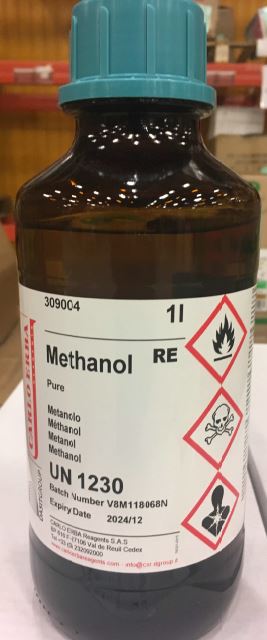METHANOL, 1 l, bot.
Valid Article
METHANOL
Definition
Alcohol used to fix blood smears and to prepare numerous reagents and to clean microscope's objectives.
Synonym
Methyl alcohol
Specifications
Technical specifications
- CAS n°: 67-56-1
- Formula: CH4O
- Liquid reagent
- Quality: pure, ultra pure
Packaging & Labelling
1 litre glass or plastic bottle
Transport Dangerous Goods
- UN1230
- Class: 3 (6.1)
- Packing group: II
- Proper shipping name: Methanol
Instructions for use
Keep the lids on the bottles; in a dry environment methanol evaporates very rapidly and in a very humid environment the fixative capacity of the alcohol diminishes due to the absorption of water.
If using the product after the expiry date has passed, check the fixative capacity with red blood cells on the smear.
Cannot be replaced by ethanol.
Please consult the “Updated laboratory procedures, 2022” available online via the Laboratory working Group sharepoint page: Laboratory Procedures and Resources.
https://msfintl.sharepoint.com/sites/msfintlcommunities/LabWG/SitePages/Laboratory-Manual-page.aspx
For offline access, contact your laboratory advisor.
Storage
- At room temperature
- Upright on the bottom shelves
- No expiry date
Waste management
Substance with hazardous characteristics. Please contact your watsan referent for advice on proper disposal.
Detailed hazard and precautionary information can be found in the safety data sheet (SDS).
Classification EC Regulation N° 1272/2008
- Flammable liquids: Category 2, H225
- Acute toxicity, Inhalation: Category 3, H331
- Acute toxicity, Dermal: Category 3, H311
- Acute toxicity, Oral: Category 3, H301
- Specific target organ toxicity - single exposure: Category 1, H370
Signal Word
Danger
| H225 | Highly flammable liquid and vapour |
| H301 | Toxic if swallowed. |
| H311 | Toxic in contact with skin. |
| H331 | Toxic if inhaled. |
| H370 | Causes damage to organs (or state all organs affected, if known) (state route of exposure if it is conclusively proven that no other routes of exposure cause the hazard). |
| P210 | Keep away from heat/sparks/open flames/hot surfaces. – No smoking. |
| P240 | Ground/bond container and receiving equipment. |
| P280 | Wear protective gloves/protective clothing/eye protection/face protection |
| P301 + P310 | IF SWALLOWED: Immediately call a POISON CENTER or doctor/physician. |
| P302 + P350 | IF ON SKIN: Gently wash with plenty of soap and water. |
| P304 + P340 | IF INHALED: Remove to fresh air and keep at rest in a position comfortable for breathing. |
MSF requirements
The chosen quality allows a very good fixation of smears and is perfectly suitable for the preparation of reagents.
Dry or "water free" methanol (maximum 0.05% of water) is better, but also much more expensive.


![[KMEDMLAB04D] (laboratory module) MALARIA REAGENTS, 1000 tests, RTR](/web/image/product.template/573208/image_256/%5BKMEDMLAB04D%5D%20%28laboratory%20module%29%20MALARIA%20REAGENTS%2C%201000%20tests%2C%20RTR?unique=f6a65ab)
![[KWATMTES1RS] (module water test, DelAgua) RENEWABLE SUPPLY](/web/image/product.template/551837/image_256/%5BKWATMTES1RS%5D%20%28module%20water%20test%2C%20DelAgua%29%20RENEWABLE%20SUPPLY?unique=ea9f702)
![[KMEDMHLA14D] (mod hospital lab) REAGENTS regulated transport](/web/image/product.template/572571/image_256/%5BKMEDMHLA14D%5D%20%28mod%20hospital%20lab%29%20REAGENTS%20regulated%20transport?unique=35f7fea)
![[ELABPIFI02-] PIPETTE FILLER, WITH THUMB-WHEEL LEVER (Pipump) blue, 2 ml](/web/image/product.template/571133/image_256/%5BELABPIFI02-%5D%20PIPETTE%20FILLER%2C%20WITH%20THUMB-WHEEL%20LEVER%20%28Pipump%29%20blue%2C%202%20ml?unique=34c8e1f)
![[ELABPIFI10-] PIPETTE FILLER, WITH THUMB-WHEEL LEVER (Pipump) green, 10 ml](/web/image/product.template/571139/image_256/%5BELABPIFI10-%5D%20PIPETTE%20FILLER%2C%20WITH%20THUMB-WHEEL%20LEVER%20%28Pipump%29%20green%2C%2010%20ml?unique=0c4a96c)